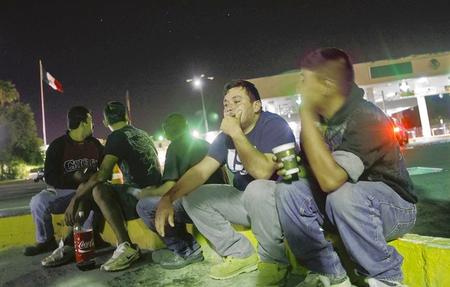In response to critics of its record-setting number of deportations, the Obama administration has begun a pilot program in Denver and Baltimore that grants discretion to Immigration and Customs Enforcement (ICE) prosecutors in relation to which cases they pursue. The prosecutors reviewed their deportation cases with the goal of identifying individuals who pose no “security risk”—individuals who have no criminal record and have strong family ties in the United States. The result is that prosecutors in Denver have allowed 1,300 individuals with deportation orders—out of 7,900 cases reviewed—to stay in the United States. According to a recent report in the New York Times, the review process will be extended “in coming months to all of about 300,000 deportation cases before the courts nationwide.”
Meanwhile, another arm of the Department of Homeland Security—namely, the Border Patrol—has provided a sneak preview of its new national strategy. Building on practices employed over the last few decades, but limited to particular areas along the Mexico-U.S. divide, the paramilitary agency now feels it is ready and able to apply these practices across the entire length of the country’s Southwest boundary. Central to the new strategy, explains the Associated Press's Elliot Spagat, is something ominously called the “Consequence Delivery System.” It will involve categorizing all apprehended unauthorized boundary crossers into “seven categories, ranging from first-time offenders to people with criminal records” and determining punishments accordingly. While some, especially children and those who are ill, will simply be returned to the nearest Mexican border town, the vast majority will experience more punitive measures. These will range from felony prosecution to what is called “lateral repatriation,” which involves transporting a migrant to a city or town hundreds of miles ways from where he crossed the boundary.
Central to the new strategy, explains the Associated Press's Elliot Spagat, is something ominously called the “Consequence Delivery System.” It will involve categorizing all apprehended unauthorized boundary crossers into “seven categories, ranging from first-time offenders to people with criminal records” and determining punishments accordingly. While some, especially children and those who are ill, will simply be returned to the nearest Mexican border town, the vast majority will experience more punitive measures. These will range from felony prosecution to what is called “lateral repatriation,” which involves transporting a migrant to a city or town hundreds of miles ways from where he crossed the boundary.
Paraphrasing Michael Fisher, head of the Border Patrol—and ignoring the well-documented abuses perpetrated by the agency against migrants they apprehend—the AP says that the old way was one in which “migrants caught in Douglas, Ariz., were given a bologna sandwich and orange juice before being taken back to Mexico at the same location on the same afternoon.” Now, by employing (among other measures) lateral repatriation, “migrants are effectively cut off from the smugglers who helped them cross the border, whose typical fees have skyrocketed to between $3,200 and $3,500 and are increasingly demanding payment upfront instead of after crossing. . . . At minimum, they will have to wait longer to try again as they raise money to pay another smuggler.”
Now, by employing (among other measures) lateral repatriation, “migrants are effectively cut off from the smugglers who helped them cross the border, whose typical fees have skyrocketed to between $3,200 and $3,500 and are increasingly demanding payment upfront instead of after crossing. . . . At minimum, they will have to wait longer to try again as they raise money to pay another smuggler.”
Despite the Border Patrol’s claim that lateral repatriation deters unauthorized migrants from returning to the United States, academic research—such as, most recently, that of anthropologist Jason De León—casts significant doubt on the assertion. What is clear is that it creates greater hardships for migrants, often placing them in physical danger.
During presidential election season in the United States, one expects the White House incumbent to try to shore up, and throw some proverbial bones to a constituency whose previous high level of support is now in some doubt—one being the large portion of the Latino electorate interested in the well-being of immigrant and border communities. With its failure to push through the DREAM Act and other liberalizing elements of the catch-all called comprehensive immigration reform, and its embracing of heavy-handed policing of the U.S-Mexico borderlands and immigrant communities in the interior, the Obama presidency has turned out to be far less favorable than anticipated, or hoped for, by immigrants and their advocates, and residents of the borderlands.
The small “carrot” of allowing ICE prosecutors some discretion in cases of deportation should not obscure the larger reality of repression that the Obama administration has helped to bring about. I ndeed, even the carrot, it turns out, is bitter: while the policy allows migrants who would otherwise have been deported to stay in the United States, they remain without legal status. Authorities could thus pick them up at any future point and send them into exile. As one affected individual quoted in a piece in The Arizona Republic explained, “It was a big relief because I was no longer afraid of having to go back to Mexico. . . . But now I am back to point zero again.”
ndeed, even the carrot, it turns out, is bitter: while the policy allows migrants who would otherwise have been deported to stay in the United States, they remain without legal status. Authorities could thus pick them up at any future point and send them into exile. As one affected individual quoted in a piece in The Arizona Republic explained, “It was a big relief because I was no longer afraid of having to go back to Mexico. . . . But now I am back to point zero again.”
There are multiple alternatives to the ugly status quo embodied by “point zero”—one being granting legal status to all unauthorized residents, as Congress and a right-wing president (Ronald Reagan) did to a significant degree not too long ago. Another, as David Bacon points out in an important article in a recent issue of The Nation, is the implementation of trade policies and agreements that do not displace workers, families, and communities in places like Mexico and drive them to the United States.
Clearly, realizing such measures is a tall order. They are ones that will not come about by clinging to the prospects of Obama-esque “hope and change,” but only through organizing and struggle that puts at the center the human rights of migrants and workers—wherever they might be.
For more from the Border Wars blog, visit nacla.org/blog/border-wars. And now you can follow it on twitter@NACLABorderWars. See also "Undocumented, Not Illegal: Beyond the Rhetoric of Immigration Coverage," by Angelica Rubio in the November/December 2011 NACLA Report; "The Border: Funneling Migrants to Their Doom," by Óscar Martínez, in the September/October 2011 NACLA Report; and the May/June 2007 NACLA Report, Of Migrants & Minutemen.

